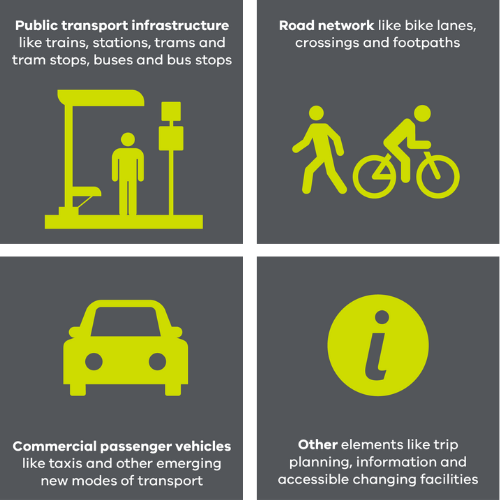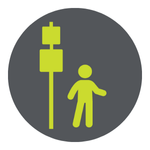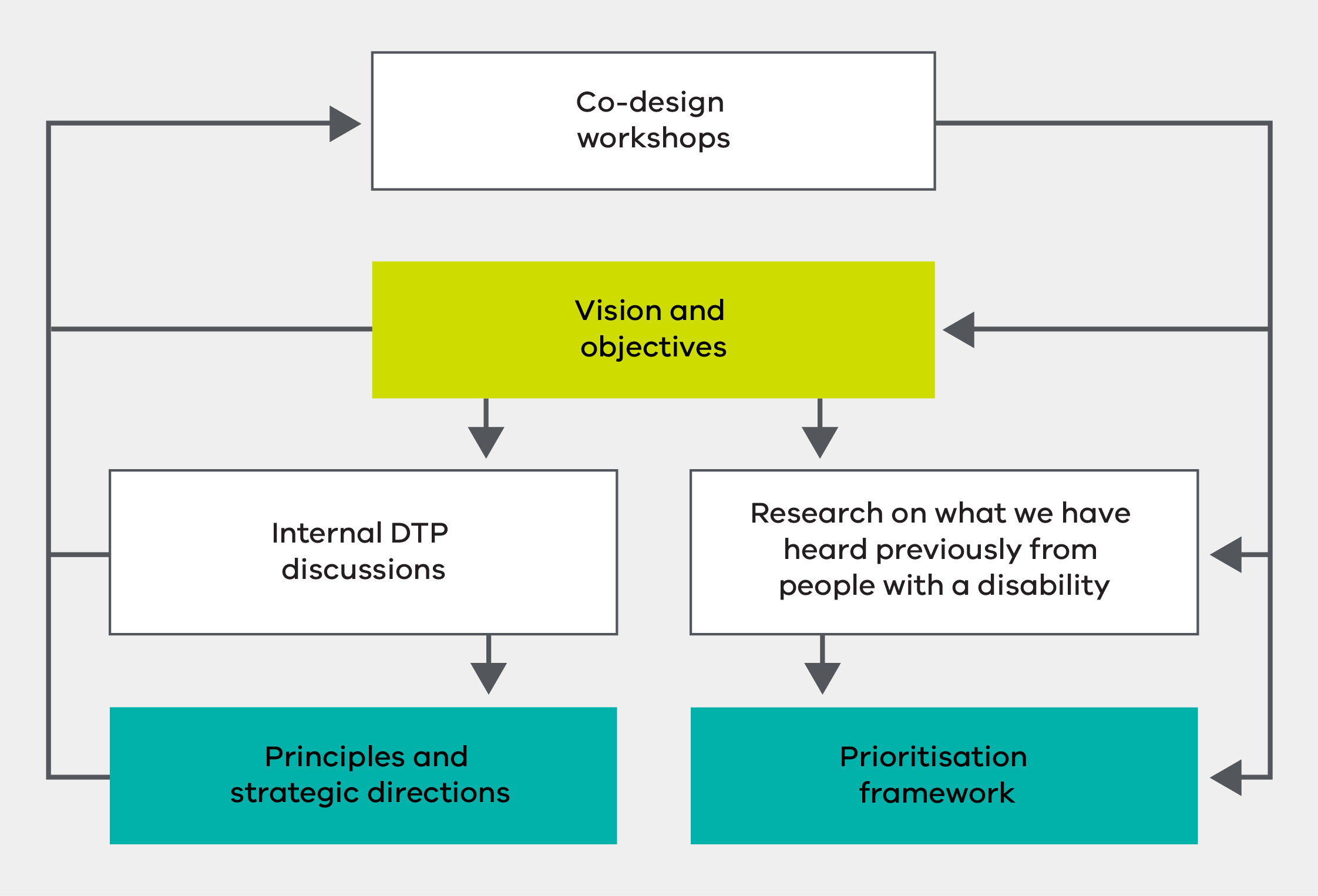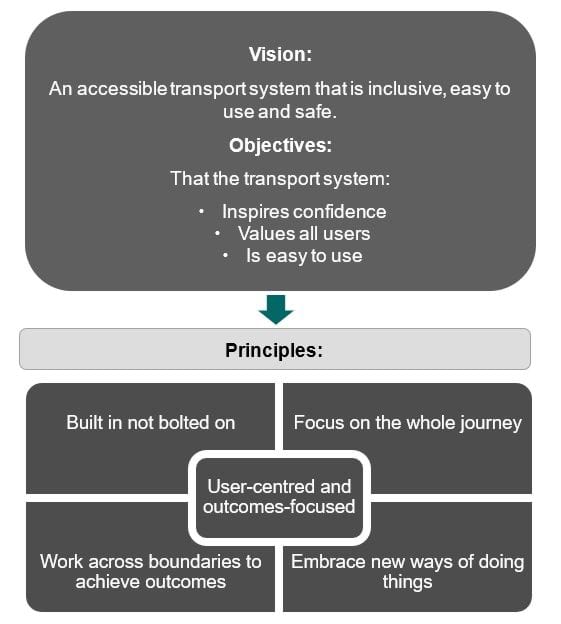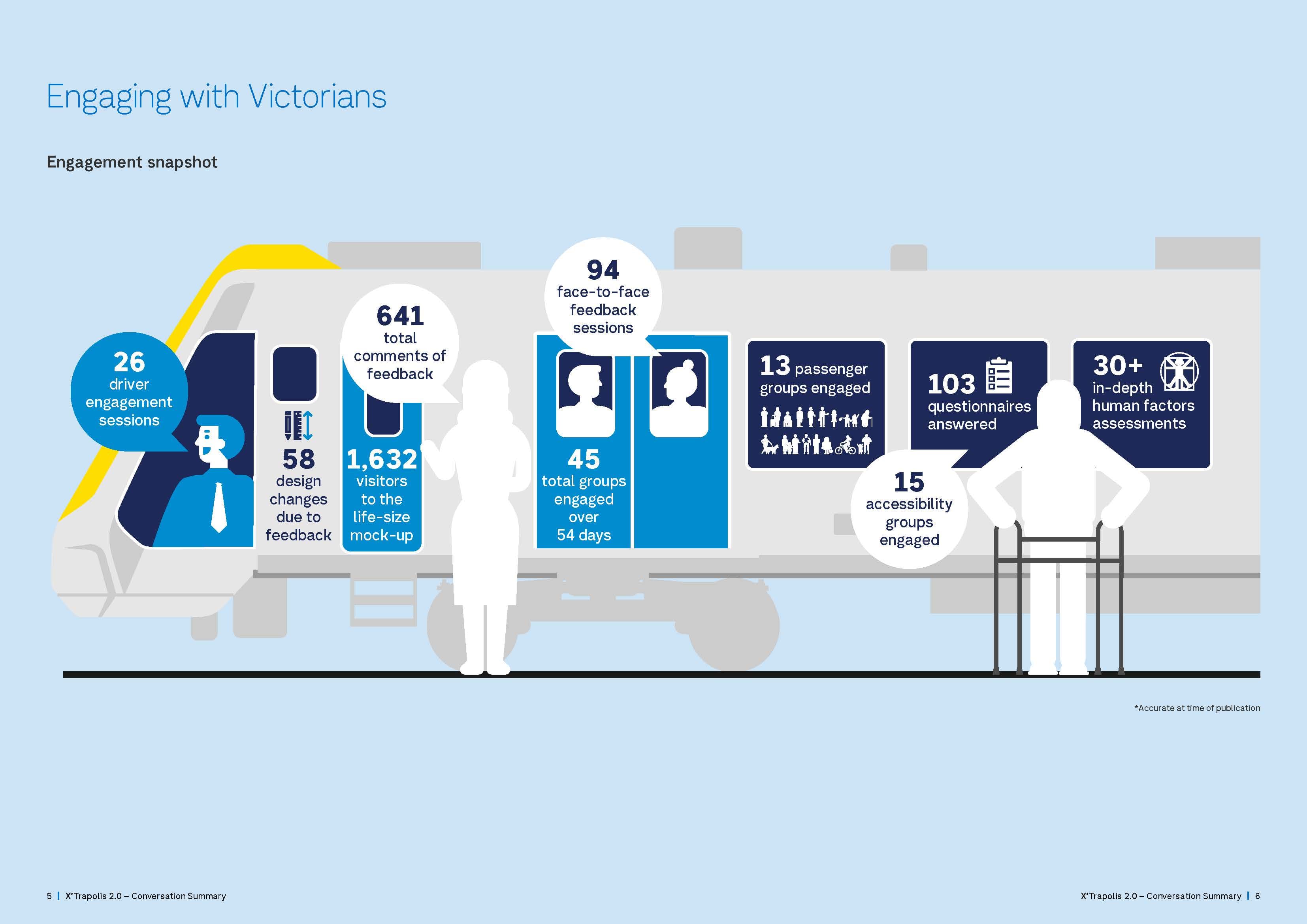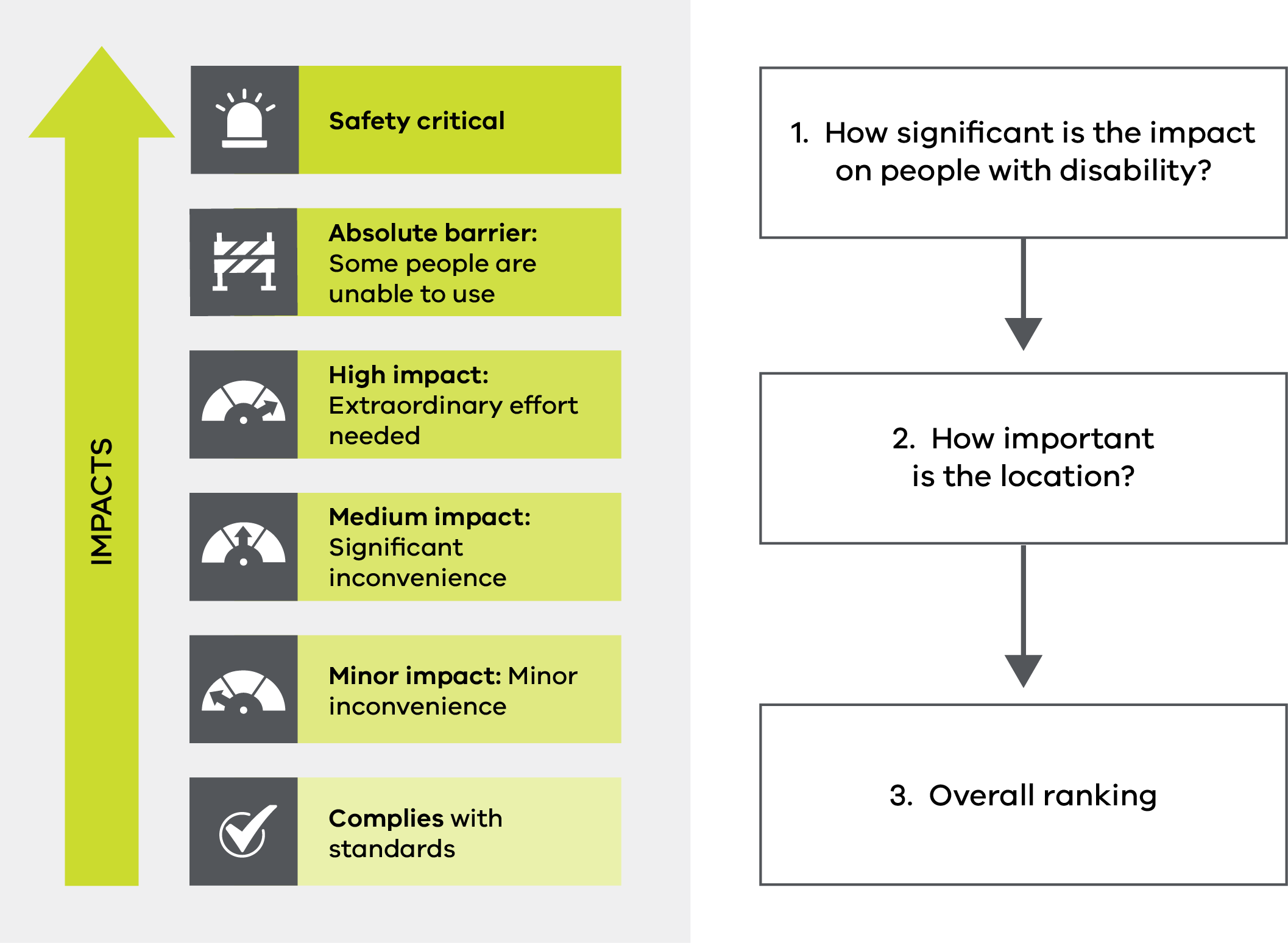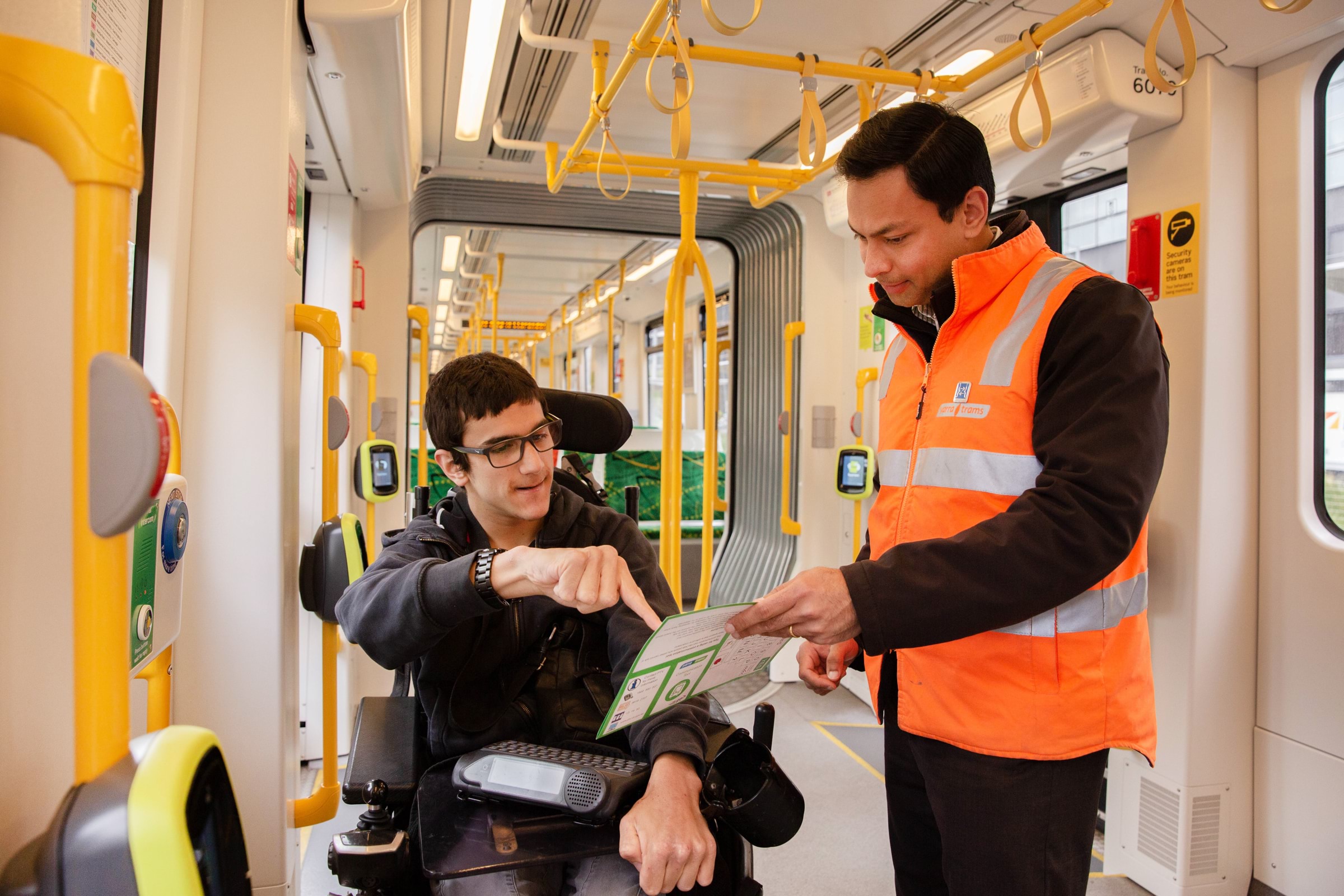
The Transport Accessibility Strategic Framework identifies the approach the Department of Transport and Planning will take in addressing accessibility gaps and improving transport experiences for everyone, particularly people with disability, in line with universal accessibility goals.
Downloads
Please contact accessibility.strategy@transport.vic.gov.au(opens in a new window) if you would like to request a document in another format.
Introduction
Purpose
The Transport Accessibility Strategic Framework (the Strategic Framework) identifies the approach the Department of Transport and Planning (DTP) will take in addressing accessibility gaps and improving transport experiences for everyone, particularly people with disability, in line with universal accessibility goals.
The Strategic Framework was co-designed with people with disability and will inform Government on how to remove accessibility barriers to enhance the end-to-end travelling experience for everyone.
The Strategic Framework focuses on accessibility for everyone, including people with disability, older people, parents with young children, people travelling with luggage, and people who have suffered a temporary injury.
The Strategic Framework recognises that the challenges some people face in using transport can be increased when put together with their age, cultural background, or other differentiating factors. It is centred on how people’s travel experiences are impacted by accessibility.
Language and definitions used
The Strategic Framework uses person-first language to emphasise individuals beyond their disability, recognising diverse language preferences and committing to inclusive practices. This language puts the person before their disability, for example, ‘person with disability’.
Person-first language emphasises a person’s right to an identity beyond their disability as a way of addressing ableism. This approach is an important part of reflecting many people’s identities, particularly those with cognitive disability and self-advocates.
While we have chosen to use person-first language in the Strategic Framework, we recognise that person-first language may not be the preferred language of the whole community and that many people with disability prefer to use ‘identity-first’ language.
This approach puts a person’s disability identity before the person – for example, ‘disabled person.’ We recognise that identity-first language is important to many people with disability, including neurodiverse people and many in the Deaf community.
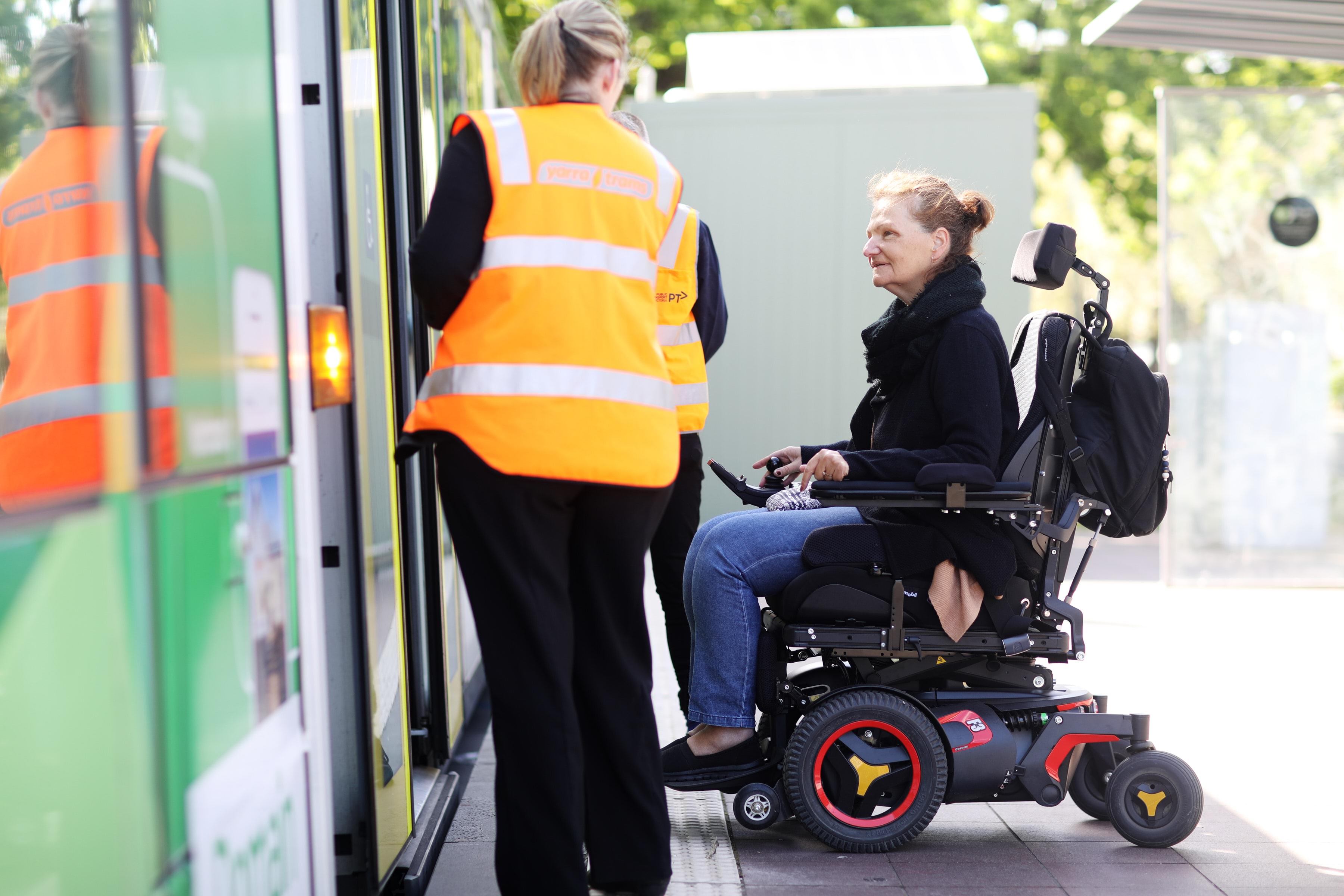
The Victorian Government has committed, through Inclusive Victoria: State Disability Plan 2022-26, to working with people with disability to understand community preferences and good practice in the language used to describe disability.
This Strategic Framework uses the United Nations Convention on the Rights of Persons with Disabilities definition of disability, which describes people with disability as people who have long-term physical, mental, intellectual or sensory differences that, when interacting with inaccessible communities and environments, prevent full and equal community participation.
This is often called the social model of disability. Under this approach, communities, services and spaces that are not accessible or inclusive cause disability.
The Strategic Framework accommodates both visible and non-visible disabilities and acknowledges that non-visible disabilities may also hinder a person’s full and equal community participation.
Recognising both visible and non-visible disabilities in the Strategic Framework is essential for fostering inclusion, promoting accessibility, and ensuring equal rights and opportunities for all individuals.
Intersectionality and diversity in disability
Acknowledging intersectionality and the diversity of disability is fundamental to understanding and responding to the multiple and compounding barriers people with disability and other diverse backgrounds experience when accessing or using public transport (Disabled People’s Organisations Australia, 2018).
Various challenges confront the Victorian transport network due to intersecting identities and diverse disabilities. These include inadequate infrastructure in rural and regional areas, language barriers for culturally diverse individuals, facilities inaccessible to LGBTQIA+ travellers, and affordability issues for low-income households.
Additionally, accommodating people with both visible and non-visible disabilities, such as physical, sensory, cognitive, or mental health-related conditions, adds complexity. A targeted accessibility strategy that considers intersectionality and diversity is needed to effectively tackle these challenges.
Recognising the diverse experiences and needs of individuals across intersecting identities, including gender, race, ability, sexuality, age, Aboriginality, cultural background, class, or immigration status, is essential.
Consultation with diverse communities, implementation of targeted support programs, infrastructure and facility improvements, accessible information and communication, and staff training are all vital for creating a more inclusive and welcoming transport environment for all Victorians.
What the Strategic Framework covers
What the Strategic Framework covers
The Strategic Framework covers the entire state-managed transport network, which includes public transport, the road network including bike lanes, pedestrian crossings and footpaths, commercial passenger vehicles including taxis, rideshare vehicles and hire cars, and other key elements such as trip planning and accessible information.
The Strategic Framework also covers all stages involved in making a journey, including pre-journey planning, when you leave home and when you get back home, interchanges, and during a trip. This includes making a trip on board a vehicle, getting in or out of a car, bus, tram, train, taxi, rideshare vehicle, or waiting for a transport service. It also includes travelling as a pedestrian on foot or with a mobility aid.
The Strategic Framework covers all the stages involved in making a journey
The Strategic Framework:
- includes a prioritisation framework to help identify the biggest challenges to accessibility
- provides an input to planning and investment decisions
- helps inform Government on how to achieve better value for money, cost efficiencies and reduce community disruption
- takes a whole-of-system view, centred on outcomes and draws on innovative thinking.
Legislative requirements
Legislative requirements
Transport providers and operators have multiple responsibilities under state and federal legislation to ensure that we protect people’s fundamental human rights, do not discriminate, and meet minimum accessibility standards. The Strategic Framework will assist transport providers and operators to meet relevant state and federal legislation.
Relevant legislative requirements include the following:
- Equitable access to public transport is a human right in Victoria – Charter of Human Rights and Responsibilities Act 2006 (Vic).
- It is unlawful for public transport operators to discriminate in the provision of public transport services – Equal Opportunity Act 2010 (Vic).
- People with disability cannot be discriminated against or treated unfairly because of their disability – Disability Discrimination Act 1992 (Cth) (DDA), which also sets legally binding standards for public transport infrastructure and rolling stock through the Disability Standards for Accessible Public Transport 2002 (DSAPT) and the Disability (Access to Premises - buildings) Standards 2010 (the Premises Standards) for new and substantially new public transport buildings.
- The Transport Integration Act provides Transport system objectives including social and economic inclusion. The transport system should provide a means by which persons can access social and economic opportunities to support individual and community wellbeing including by –
- minimising barriers to access so that so far as is possible the transport system is available to as many persons as wish to use it;
- providing tailored infrastructure, services and support for persons who find it difficult to use the transport system.
- The State is required to take appropriate measures to enable persons with disabilities to live independently and participate fully in all aspects of life. The State must ensure persons with disabilities have access, on an equal basis with others, to the physical environment, to transportation, to information and communications, and other public facilities and services, both in urban and in rural areas – United Nations: Article 9 - Accessibility, Convention on the Rights of Persons with Disabilities.
Consequences associated with non-compliance with DSAPT range from social impacts around inclusion and participation to wider economic, environmental, and legal risks.
DSAPT
Where compliance with DSAPT is not possible, public transport providers and operators can seek an exemption from the Australian Human Rights Commission or rely on an available defence, including:
- Equivalent access – under which a provider or operator is permitted to vary the equipment or facilities so long as an equivalent standard of amenity, availability, comfort, convenience, dignity, price and safety is maintained. Equivalent access can be provided by direct assistance, such as a train driver providing a boarding ramp.
- Unjustifiable hardship – under which compliance with DSAPT would result in an unjustifiable hardship for the public transport provider or operator.
Development of the Strategic Framework
We developed this Strategic Framework by speaking with people with disability and other diverse backgrounds through co-design workshops, focus groups, and interviews. We also consulted local councils, train, and tram operators. The co-design workshops were critical, directly informing the Strategic Framework's objectives and testing its elements to ensure they aligned with what participants said make an accessible transport system.
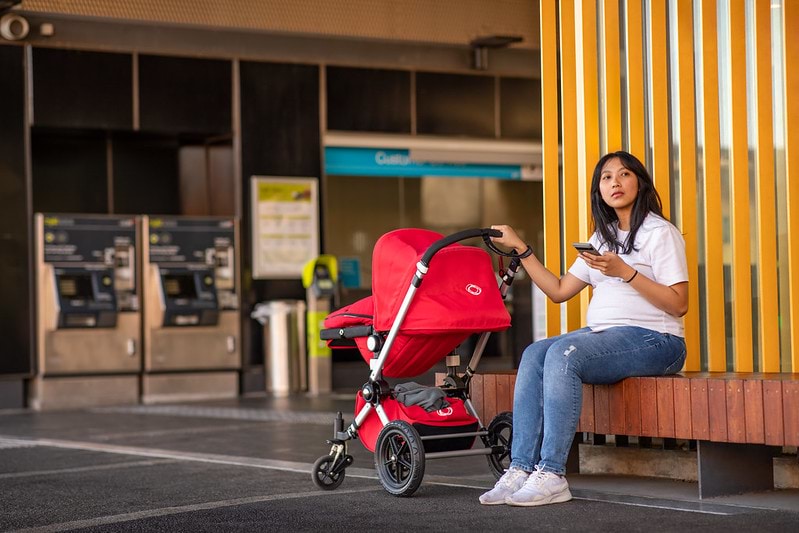
We held multiple co-design workshops over several months, beginning in late 2021 through to mid-2022. We also held focus groups and one-on-one interviews with people who were not able to participate in the workshops. Many diverse groups of people were included.
The co-design workshops with people with disability and other diverse backgrounds were the first step in developing this Strategic Framework and were critical to its development. Feedback from these workshops has been the primary input to the Strategic Framework.
The workshops directly informed the objectives of the Strategic Framework, and we tested all the elements of the Strategic Framework with participants of the co-design workshops to ensure that they helped get us closer to what we have heard people are looking for as an accessible transport system and what would make the biggest differences to their experiences.
At each stage of development of the Strategic Framework, the elements were tested with the participants of the co-design workshops to confirm that they aligned with the discussions and reflected workshop thinking.
In late 2023, people with disability, people from other diverse backgrounds and local governments reviewed a draft of the Strategic Framework.
The problem
Opportunities to improve accessibility
People value reliable transport, respectful treatment, well-connected services, and inclusive experiences. Safety is crucial. Giving people choice and control boosts confidence in navigating independently. Addressing accessibility pain points at each stage of a journey and providing comprehensive information empowers confidence and ease of use.
People have told us that good transport means:
- it is reliable
- people are treated respectfully, regardless of their background
- services are well-connected
- the experience is inclusive for everyone.
Safety is also seen as essential for a positive travel experience.
Workshop participants expressed their desire for more choice and control over how they travel. This would increase their confidence to get around the network independently and enable more people to travel without relying on support workers or transport staff.
We heard that by making the transport system easier to use for people with disability, everyone in the community would find it easier to use, including older people, parents with young children, people travelling with luggage and people with temporary injuries.

What we heard
We have heard from people about where the greatest opportunities are to address their accessibility pain points in each of the four stages of a journey – pre-journey planning, journey start and end, interchange, and taking the trip.
We heard from people with disability that perhaps the most effective tool to empower people to feel confident and valued, and to make the network easy to use, is to provide better information. Passengers need better information at all stages of the journey, from planning travel to arriving at the destination and back home again.
Current transport network
Since the introduction of the Disability Standards for Accessible Public Transport (DSAPT) in 2002, Victoria has invested heavily in new and upgraded public transport infrastructure and rolling stock. This provides opportunities to improve accessibility by building accessibility into new designs. These investments transform accessibility, but we still face challenges due to aging infrastructure and rolling stock built some time ago to older standards and the high costs of upgrading or replacing it, the size of the network, as well as significant gaps across the transport network.
In some cases slopes and curves make meeting standards very hard. Many tram stops and train stations (especially in regional areas) remain hard to access. Accessibility varies widely across the state, with footpaths also playing a critical role.
Victoria faces significant challenges in making our transport network fully accessible. Key barriers include the age of much of our existing infrastructure (some parts of the network were built 170 years ago) and rolling stock, the size of the network, and the high cost of upgrading or replacing it:
- New level access stops are being progressively built, but around 75 per cent of tram stops do not have raised platforms that facilitate level access entry to low floor trams and around 60 per cent of the tram fleet have high-floors.
- New and upgraded train stations are also being progressively delivered. Many older train stations exist in metro and regional areas, and some of these have issues that limit independent access. The problems are most significant where the stations are the oldest. Many older trains and carriages that are not fully accessible are still in use.
- There are more than 26,000 bus and coach stops in Victoria. Accessibility varies considerably across this network. Some areas, like Melbourne’s middle suburbs in the south and east, where infrastructure is often older, have a higher proportion of inaccessible stops.
- Footpaths play a critical role in accessibility, but their responsibility is shared between local councils and DTP.
- While accessibility is about all areas in Victoria, regional areas face additional challenges such as fewer and less frequent public transport options, limited wheelchair-accessible taxis, inadequate footpaths and crossings, varying accessibility features on vehicles and at stations, and limited accessible infrastructure like ramps, elevators, and accessible parking spaces.
The Strategic Framework provides a way to look at these challenges across the State and advise on what are the most important things to fix first, based on how people will be impacted.
Policy and strategic context
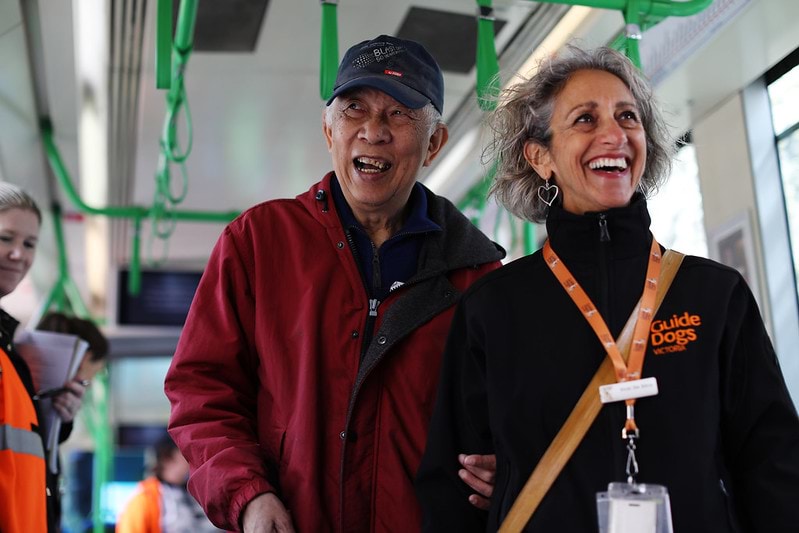
Alignment with strategies, policies and plans
The Strategic Framework aligns with various Victorian strategies, policies and plans. The Strategic Framework supports the overall purpose and strategic directions for DTP and the State Disability Plan.
It will guide transport initiatives to enhance accessibility and embed systemic reforms outlined in the State Disability Plan and the Transport Portfolio Aboriginal Self-Determination Plan.
The Strategic Framework guides transport strategies and plans with a direct role in progressing transport accessibility as well as guiding broader transport strategies, policies and plans to ensure that they also work towards meeting accessibility needs.
This Strategic Framework seeks to embed the six areas for systemic reform set out in Inclusive Victoria: state disability plan (2022–2026) (opens in a new window)(the State Disability Plan), Victoria’s plan for making our community inclusive and accessible for everyone. The six areas of systemic reform are:
- Co-design with people with disability
- Aboriginal self-determination
- Intersectional approaches
- Accessible communications and universal design
- Disability confident and inclusive workforces
- Effective data and outcomes reporting
The State Disability Plan includes a commitment to work across government to embed universal design principles in all elements of the design and delivery of infrastructure.
It also includes commitments to a series of actions, including commitments aimed at creating an inclusive and accessible transport network in partnership with Victorians with disability so they can travel easily when and where they need to go as part of creating inclusive communities.
Actions aim for:
- public transport to be more accessible
- more accessible or adapted footpaths and crossings
- more spaces and places with universal design
- increased access to transport
- greater mobility for people with disability
- embedding provision of fully accessible public toilets in the design and delivery of major infrastructure and transport projects.
The Strategic Framework sits alongside the Transport Portfolio Aboriginal Self-Determination Plan (the Self-Determination Plan). The Self-Determination Plan is the framework for a whole-of-transport approach to embedding self-determination and ensuring our transport system is informed by the voices of Aboriginal Victorians.
The Plan formalises how the transport portfolio will work together as one in a coordinated, integrated fashion to deliver outcomes with, and for, Aboriginal Victorians.
VPS Values
This Strategic Framework is underpinned by the seven core Victorian Public Sector (VPS) values outlined in Section 7 of the Public Administration Act 2004, committed to working with Responsiveness, Integrity, Impartiality, Accountability, Respect, Leadership, and protection of Human Rights.

Diagram: A logo with text outlining the seven VPS values: responsiveness, integrity, impartiality, accountability, respect, leadership, and human rights.
This Strategic Framework will demonstrate our commitment to:
Our approach
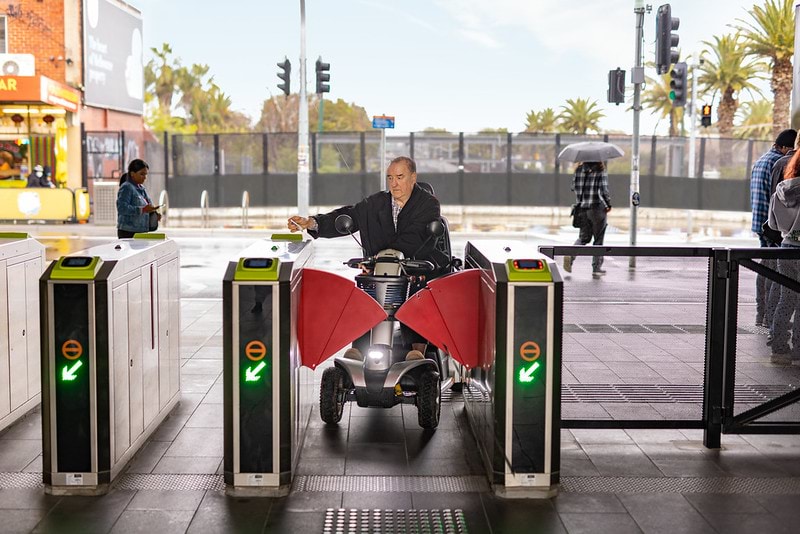
Vision
DTP’s vision is for Victoria to have an accessible transport system that is inclusive, easy to use and safe.
Transport enables people to live full and rich lives by allowing them to get to the places they wish to go. Transport means people are connected to their communities and can participate in activities by connecting to jobs, education, health and other services, shops, social opportunities and recreation.
For some community members, accessing transport is challenging, limiting their ability to make the journeys they want. A person’s gender, race, ability, sexuality, age, class or immigration status may mean their experience of the same event is different to someone else’s, but this should not lead to them being or feeling excluded from making a transport journey or feeling that their experience does not matter.
Objectives
We have defined objectives for the Strategic Framework based on what we have heard people are looking for from transport. Our objectives are to develop the transport system so that it: inspires confidence; values all users; is easy to use.
Transport Accessibility Strategic Framework Objectives
Principles
We have identified five principles to determine how we should work together to achieve the vision and objectives of this Strategic Framework while providing ongoing responsiveness to all transport users, including those with disability and other diverse backgrounds. These principles are:
- We are user-centred and outcomes-focused
- Accessibility is built-in not bolted-on
- We focus on the whole journey
- We work across boundaries to achieve outcomes
- We embrace new ways of doing things
Principle 1: We are user-centred and outcomes-focused
We are user-centred and outcomes-focused
A user-centred, outcomes-focused approach means that transport planners, designers, delivery teams and operators should ask a broad range of users what they need and what works so that transport is accessible for all individuals, regardless of age, cultural background, disability, or other differentiating factors. This principle supports using an intersectional lens when developing policies and projects.
Outcomes-focused, user-centred approaches should apply to planning, design, delivery and operation of all services and assets that impact on the experiences of users.
This approach supports the principles of the State Disability Plan. It will ensure that improvements to the transport system work for all, so that everyone can use the system more easily, have trust and confidence that the improvements will work, and feel respected and valued.
This Strategic Framework aims to enable a more equitable and accessible transport system for all Victorians, regardless of their intersecting identities and abilities. It prioritises equity, cultural competence, accessibility, affordability, and the provision of targeted support services tailored to meet the diverse needs of people with accessibility requirements in Victoria.
Case study: The new X’Trapolis 2.0 trains
Targeted engagement
Through a targeted engagement program, hundreds of Victorians were given the chance to influence the design of Melbourne’s new X’Trapolis 2.0 train.
The four-phased engagement program ran from April 2022 to July 2023, and involved consultation with train drivers, accessibility groups and passenger representatives on early concept designs, followed by virtual reality tools and a life-size mock-up, to help inform the final design of the train.
During the final engagement phase, 1,632 diverse visitors experienced and provided feedback on a mock-up of one-and-a-half train carriages.
The mock-up
The mock-up featured life-like passenger features, allowing participants to experience passenger displays, seats, grab poles, accessibility spaces, and many other key elements of the design. We received 641 individual pieces of feedback, which resulted in 58 important design changes, including:
- improvements to the semi-automatic wheelchair ramp to make it easier for mobility aid users to get on and off the train, and make deployment of the ramp easier for drivers
- additional braille and tactile markings to priority seats
- lowered help point buttons to make calling for assistance easier
- increased space under companion seats to make it easier for guide dogs and support animals to fit
- installation of flashing lights on the doors and additional audio tones to signal doors opening and closing
- additional high-visibility markers on internal and external doors to improve accessibility.
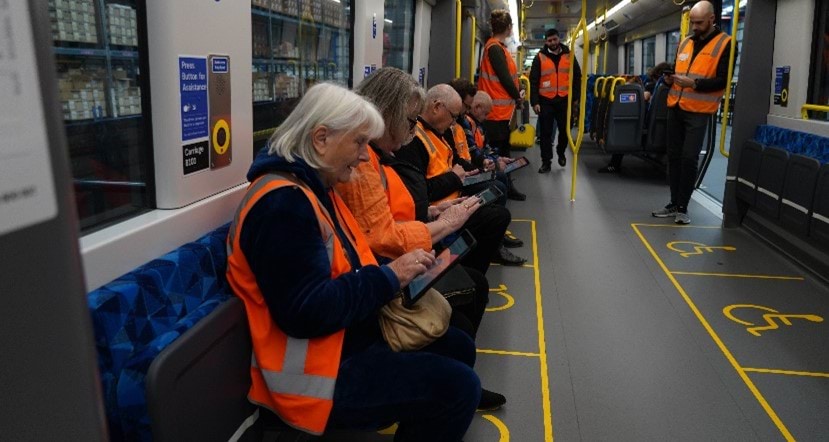
Photo of a group of people in orange vests sitting on a train mock-up and recording their feedback.
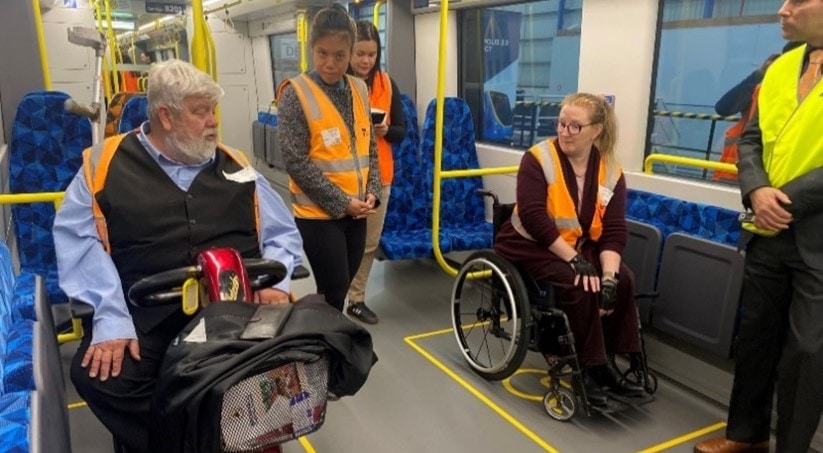
Photo of a group of people on the X’Trapolis 2.0 train mock-up. One person is using a manual wheelchair, and another is using a mobility scooter.
Co-design
Co-design is vital to ensuring our new trains and trams are being built for all Victorians right from the beginning. By actively involving key stakeholder groups in the design process, we gain valuable insights into accessibility challenges and have been able to identify issues and opportunities for improvements before our new trains and trams start taking passengers.
These changes improve passenger and driver experience, making journeys more comfortable and accessible.
“Seeing some of the feedback included in the final design is a testament to the way the teams at DTP and Alstom, along with our partners, are working together to listen to the community and come up with the best possible product.”
Tricia Malowney, DTP Chief Accessibility Advocate
Victorians can expect to see the first X’Trapolis 2.0 trains testing on the network from 2025. These trains will be gradually introduced on the Craigieburn, Upfield and Frankston lines as we retire our long-serving Comeng Fleet.
For more information
Principle 2: Accessibility is built-in, not bolted-on
Accessibility is built-in, not bolted-on
Accessibility should be built in at all stages of decision-making, from when early planning starts until a new asset, system or service is delivered and operating.
We should apply Universal Design Principles so that transport products, buildings, environments, programs, services and experiences are accessible to as many people as possible, regardless of their age, level of ability, cultural background, or additional differentiating factors.
Removing barriers will make the transport system easier to use for everyone. It will also improve journey reliability and help people feel more respected and valued.
Universal Design
Universal design ensures that products, buildings, environments, programs, services and experiences are accessible to as many people as possible, regardless of their age, level of ability, cultural background or any other differentiating factors.
Universal Design Principles
Case study: 2022 William Street / Collins Street Tram Stop Upgrade
In February 2022, Stop 4 on William Street was rebuilt as an accessible tram stop to support low-floor trams and low-access boarding on Route 58, as well as improve passenger safety. Given the sloping location, this was challenging, requiring innovation in the design. We also installed better lighting, new audio and visual passenger information displays. Building level access tram stops improves public transport options for passengers, especially those who use a wheelchair, are blind or have low vision, or are travelling with prams or luggage. We also improved safety at the stop by separating passengers from traffic, cyclists and trams with more pedestrian crossing points and new collision barriers and fencing.

Cross-section image of low floored trams at a platform stop with traffic and bike lanes on the outer sides of the road.
Principle 3: We focus on the whole journey
We focus on the whole journey
We must consider all elements of a journey to ensure all users are able to make the trips they want. If any leg of a trip cannot be made because it is inaccessible, the whole trip is inaccessible to the user.
This means footpaths, bike paths, and crossings at the start and end of trips must be accessible. It also means thinking about making accessibility-friendly routes easy to find. Access to information and assistance when something goes wrong can make the difference between a good journey and a bad one.
A whole-of-trip focus will make it easier for all users to get where they want to go, help more people travel independently and reliably and remove barriers so that people feel more respected and valued.
Case study: Buses and bus stops
DTP upgraded Huntingdale Station bus interchange in 2018 to improve safety and accessibility. The interchange is integrated into station access and the surrounding area. The upgrade improved pedestrian access to the station and the interchange. Station access ramps sit directly alongside bus waiting areas, with tactile delineators in place to help guide people with low vision or who are blind on where to go. Widths allow good circulation and passing room.
The City of Monash has examined the design of the urban precinct in the area around the station, including access via pathways and trails, extending the benefits of the improvements in the station / interchange to the surrounding land uses.
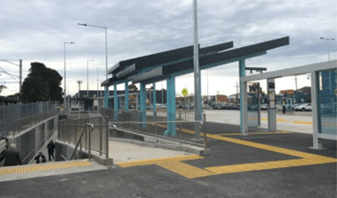
A photo of Huntingdale station bus interchange with a ramp and stairs next to each other.
Principle 4: We work across boundaries to achieve outcomes
We work across boundaries to achieve outcomes
When taking a journey, it shouldn't matter which organisation is in charge of different parts of the transport system. Different organisations are responsible for different parts (like footpaths, stops, and stations), and they all need to work together. This includes local councils, private operators, and DTP and its agencies.
Collaborating across organisations to remove accessibility barriers will achieve more than what each organisation can do alone. This will make trips easier, better respond to users' needs and help them travel more confidently.
Principle 5: We embrace new ways of doing things
We embrace new approaches and ways of doing things
Technology can help overcome some of the accessibility problems with older parts of Victoria’s public transport system and make possible other improvements that are not covered by DSAPT requirements. These include simpler forms and processes, easier ways to use transport infrastructure, improved wayfinding, and service coordination.
Embracing new approaches and technologies will help people feel more confident about their journeys. This also helps everyone feel valued and make it easier to use transport.
Case Study: Next Generation PTV Mobile Application
The Next Generation PTV mobile application (PTV app) enables all Victorians to access their travel needs in one place easily. The PTV app is completely accessible and provides significantly more functionality for passengers who are blind or have low vision.
It is compatible with audible technology apps including VoiceOver and Talkback and has a large font option. DTP worked with Vision Australia to test the PTV app and ensure it meets all accessibility standards.
Navigation to the main menu is available on each page. Passengers can plan their journey and access route numbers through the journey plan summary and receive alerts relating to a specific stop or route. Other features include dynamic mapping, accessible alternate formats, and myki account integration.
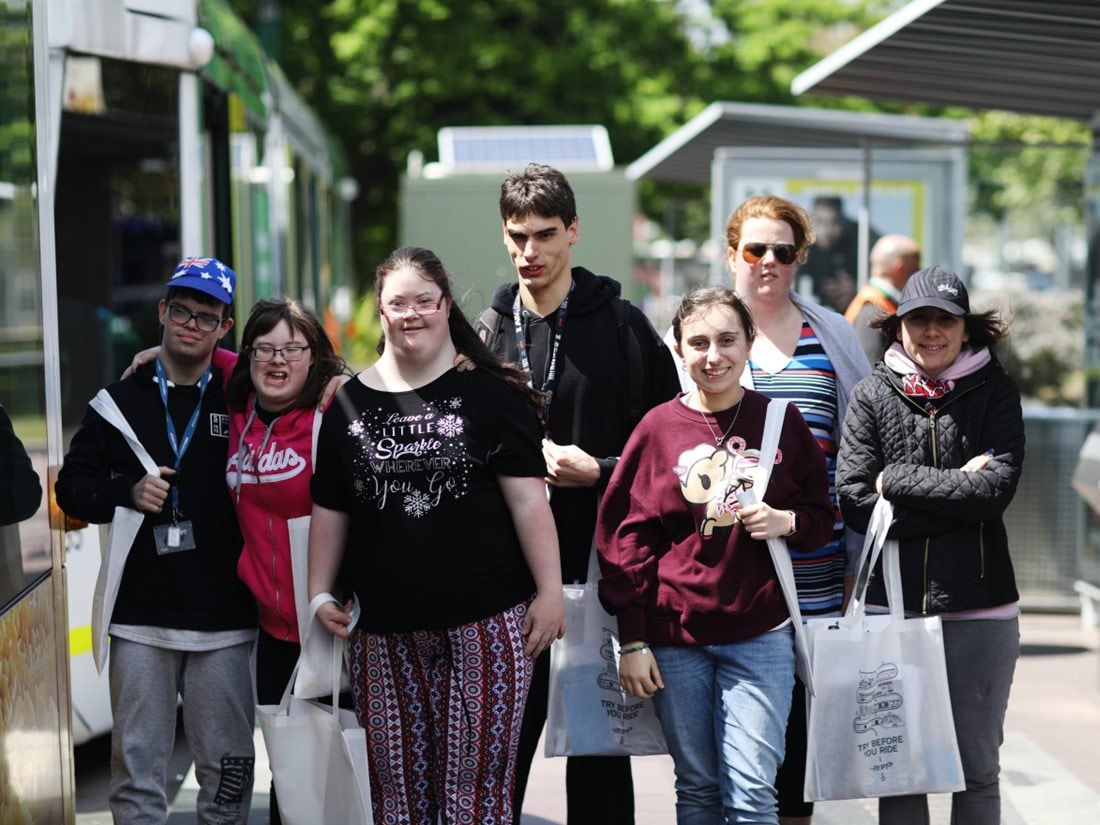
Photo of a group of people participating in the Try Before you Ride program walking along a tram stop platform.
Strategic directions
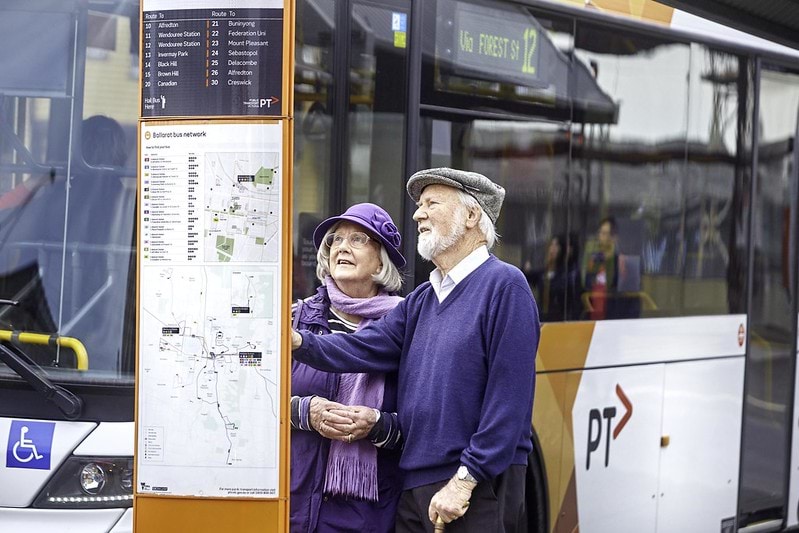
To support achieving our vision and objectives for accessibility, a series of strategic directions are identified in this Strategic Framework that outline key approaches that can be taken to improve accessibility. The strategic directions help embed the principles identified in the Strategic Framework and are grouped into four categories:
Assets
To address barriers and safety concerns, we need to focus on prioritising accessibility investments in transport infrastructure, integrating accessibility into all infrastructure stages, and enhancing universal design standards for transport assets.
People have told us that accessible infrastructure and rolling stock are fundamental to making transport an inclusive, barrier-free environment. We have also heard that, while some assets pose barriers, others may pose a risk of fatality or a serious injury. The impact of these critical barriers and safety risks on users are significant as they mean some assets are not able to be used by some people. Particular issues exist with bus stops and accessible tram stops, footpaths and pedestrian crossings. Addressing these risks is a priority for DTP.
Strategic directions for assets are to:
- Prioritise investments to identify the interventions that will deliver the most benefits so they can be completed first.
- Embed accessibility in infrastructure projects at all stages.
- Design new infrastructure and replacement rolling stock, and all parts of the transport network such as footpaths, bus stops, tram stops and train stations, so that they can all work together and reduce the need for additional supports like ramps to get from the platform to the train.
- Improve guidance and standards to apply universal design in supporting accessible outcomes for infrastructure projects and design.
- Manage existing infrastructure to ensure accessibility outcomes continue to be delivered.
Case study: New accessible stations as part of the Big Build
As at May 2024, since 2015, the Level Crossing Removal Project has completed 76 level crossing removals and delivered 40 new and upgraded metropolitan train stations with accessibility as a key feature. All-new stations have been designed to meet DDA requirements and the disability standards.
New stations are being designed using universal and equitable access principles, for example:
In November 2021, five level crossings were removed and three new stations opened at Edithvale, Chelsea and Bonbeach on the Frankston line. The project includes five new pedestrian crossings and upgrades to 10 existing pedestrian crossings to modern safety and accessibility standards. The designs include marked accessible parking, accessible ramps and lifts big enough to accommodate mobility scooters, wheelchairs and prams.
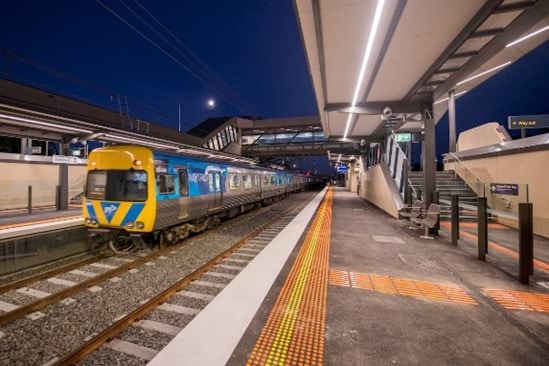
Photo of the new Bonbeach train station, showing a train coming to a stop and the tactile group surface indicators.
Journeys
We can improve transport journeys and enhance accessibility and flexibility by integrating services, exploring diverse delivery models, and improving infrastructure and support provisions for all users.
The strategic directions relating to journeys explore a range of opportunities to make it easier for a wider range of people to use transport and bridge the gaps between the options currently available in metropolitan and regional Victoria. Accessibility should be built into the way journeys are delivered, not just assets, and the first and last leg of the customer’s journey should be integrated.
Greater focus on aligning services available through coordination, tools, and contractual arrangements is possible. This can help people with disability and others who experience challenges using transport with greater flexibility to take journeys when and where they wish.
Strategic directions for journeys are to:
- Explore how public transport services can be expanded utilising innovative ways of delivering services including a broader variety of delivery models and vehicles (including taxis, rideshare and community transport vehicles) to meet the community’s accessibility needs.
- Better integrate the provision of transport services to local communities, including in regional areas.
- Explore ways to make wheelchair-accessible services more widely available, safe and comfortable.
- Align services and infrastructure to provide confidence in the regularity of accessible services.
- Clarify the levels of service (types of supports and facilities) that will be available at interchanges (e.g., where personalised or buggy services will be available, availability of changing places facilities).
- Utilise travel training to help familiarise people with using transport services.
Case study: Broadening the Multi-Purpose Taxi Program
The Multi-Purpose Taxi Program (MPTP) is a government initiative that assists people with accessibility and mobility needs by offering a 50 percent subsidy for commercial passenger vehicle travel. The program is available to people with a permanent disability who are not able to use public transport.
To ensure that MPTP members have choice and supply of services, the program was extended to include new forms of commercial passenger vehicles such as rideshare providers. This means MPTP members are no longer restricted to using taxis for subsidised travel but can now choose to travel with MPTP-accredited rideshare providers as well.
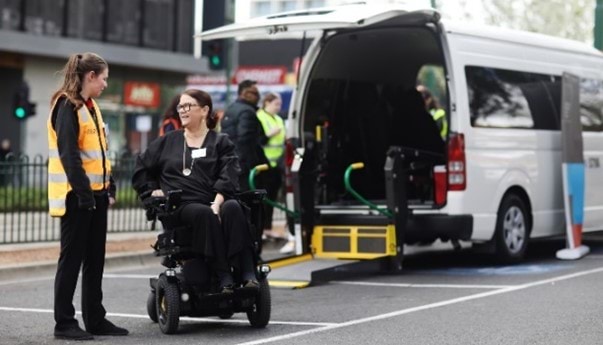
Photo of a person in a motorised wheelchair and a customer officer chat outside a wheelchair accessible taxi with the wheelchair lift down on the ground.
Organisation culture and public behaviour
While assets used in transport are important, a good travel experience relies on more than accessible infrastructure and rolling stock. It also relies on positive interactions with people along the way. To do this, we need to promote awareness of accessibility challenges and cultural sensitivity, enhance staff training, involve diverse perspectives in decision-making, and foster respect among transport users.
We want to support frontline and other staff and the wider community in increasing their awareness of the challenges faced by people using the transport network, better understanding how their actions can impact on the travel experience of all people, and recognising how they can meet needs for Aboriginal cultural safety.
Strategic directions for organisation cultures and public behaviour are:
Case study: CPVV (Safe Transport Victoria) Disability Awareness Campaign ‘You make the difference’
The Commercial Passenger Vehicles Victoria (CPVV) disability awareness campaign ‘You make the difference’ ran from December 2021 to March 2022. The aim was to change the behaviour of drivers when transporting people with disability.
The campaign generated over five million impressions (number of times the content was displayed) from all mediums and was praised by booking service providers, drivers and industry participants.
Street signage alone saw 630,518 impressions, while media outlets such as DriveNow featured a full A4 infographic on transporting people with disability. CPVV also used prominent disability advocates with lived experience. Advocates included Carly Findlay (Appearance Activist), Heath Davidson (Paralympian tennis player) and Tricia Malowney (DTP Chief Accessibility Advocate).
From a follow up survey of commercial passenger vehicle drivers, 35 per cent of respondents said this campaign changed their views on transporting passengers with disability.
For more information visit Safe Transport Victoria - You make the difference(opens in a new window)
Information and innovation
Having accessible reliable information is one of the most important requirements for inclusive transport. Addressing digital exclusion and ensuring equal access for all Victorians is key to achieving this.
We have heard from people with disability that the absence of information about the accessibility of transport facilities and services makes travelling extremely difficult. We have also heard that, even when information does exist, it can be inaccessible to some people (these include people who are deaf, blind, have low vision or cognitive disability or are restricted in their view, for example, by their height, seated position on a mobility aid etc).
It is especially hard to plan a journey without basic accessibility information. We have heard that the effort required by people with disability to plan a journey can take hours away from other activities or can be overwhelming. For others in the community, most trips can be made spontaneously, something many people with disability can currently only aspire to achieve.
Implementing measures to ensure that people with a disability and other diverse backgrounds do not experience any digital exclusion in accessing information is crucial. Leveraging innovative technologies and designing digital platforms with accessibility features such as screen readers, text-to-speech capabilities, and alternative input methods, will guarantee that everyone, regardless of their accessibility requirements, can effortlessly obtain the information they need to navigate the Victorian transport system.
To make it easier for all people to use transport, we need to fill gaps in information, keep information up to date and ensure it can be easily found and accessed. The aim should be that inability to access necessary and accessible information does not prevent full and equal community participation for all Victorians.
Strategic directions for information and innovation are to:
- Fill data gaps so that data is consistent and can be made into useful information for users and decision-makers.
- Information should be available to enable all users to plan their journeys with confidence, regardless of whether the network and system are operating as usual.
- Data, information and announcements should be readily available and provided in accessible formats including online digital and other forms to meet all users’ needs.
Case study: Video walk-throughs of train stations
V/Line and Metro Trains Melbourne both provide virtual station tours via video to give customers a better understanding of the layout, look and feel of stations prior to travel as an interactive journey planning and wayfinding experience. Customers can explore key areas of the station and locate accessibility features, such as accessible parking, toilets and elevators, along with boarding assistance zones on platforms.
Metro Trains
Eight Metro stations have virtual tours available, with accessible documents describing the tours for people who are blind or have low vision.
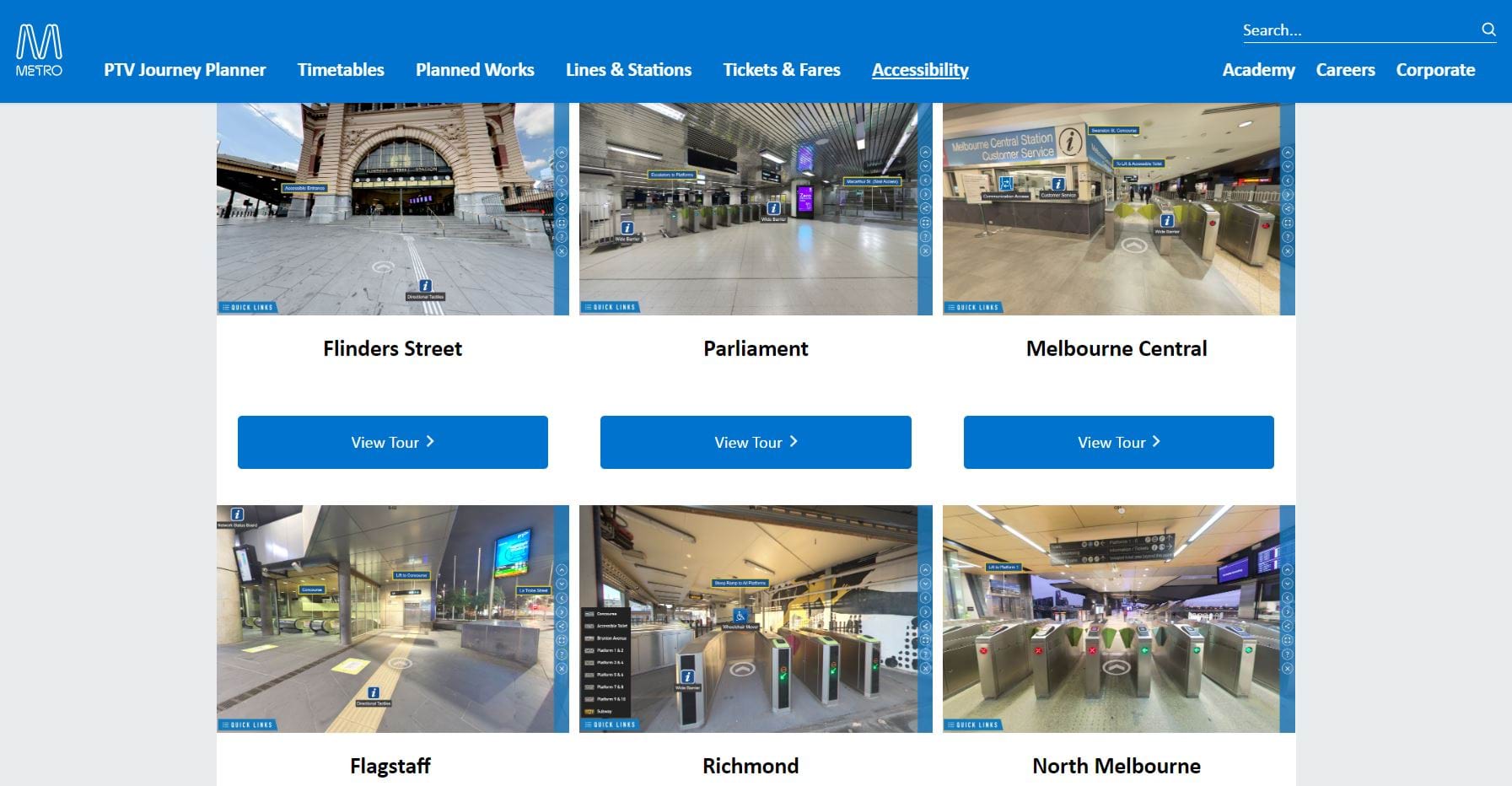
For more information visit the Metro Trains virtual tour webpage(opens in a new window).
V/Line
Virtual tours are available for 32 V/Line stations.
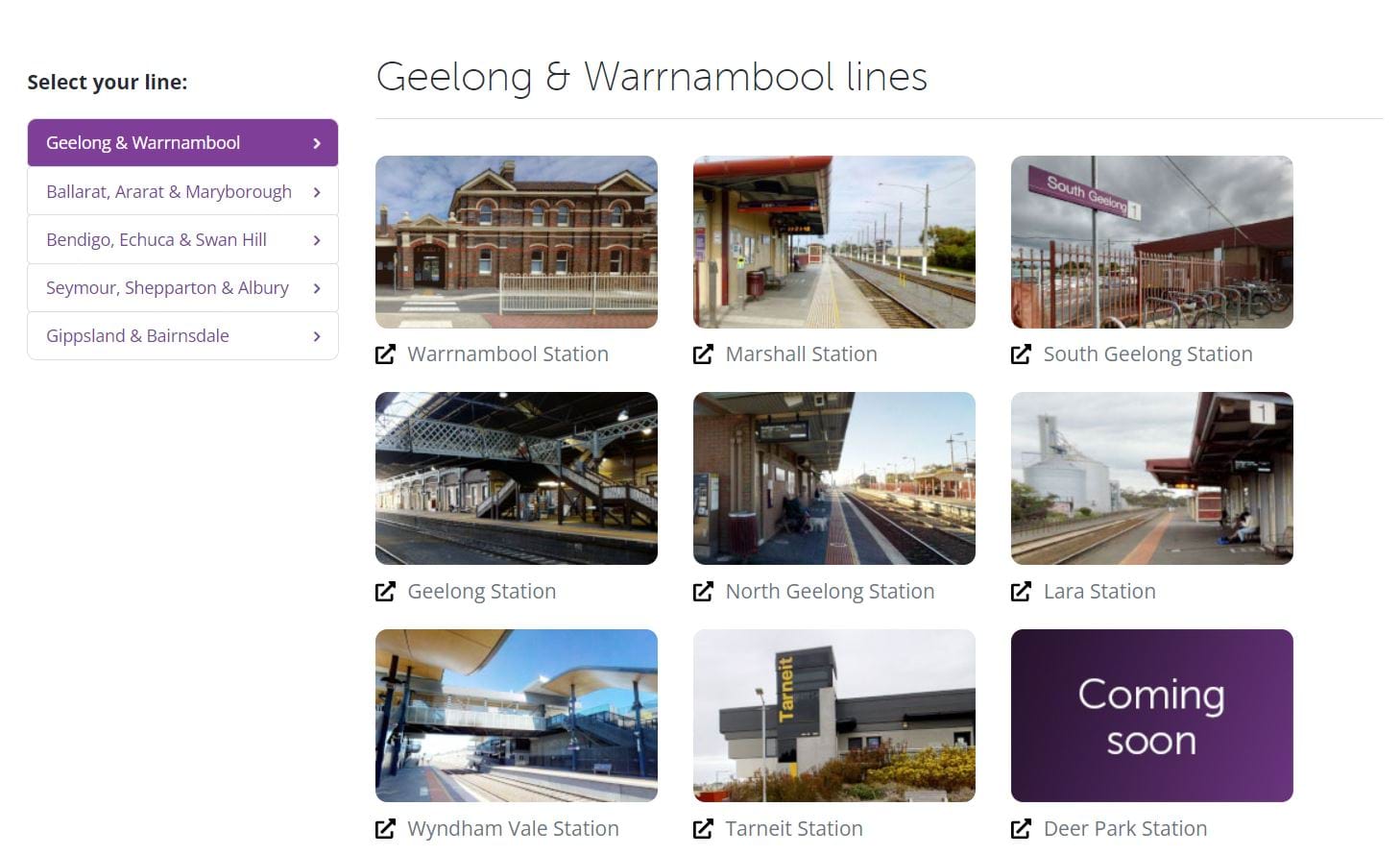
For more information visit the V/Line virtual tour webpage(opens in a new window).
Identifying high impact upgrades
Prioritisation method
The Strategic Framework establishes an advanced method to identify priorities in fixing transport accessibility issues (the Prioritisation Method). It was developed through consulting with people with disability to understand their needs, through analysing the issues and looking at best practice in other jurisdictions.
The Prioritisation Method outlines how to prioritise upgrades based on available resources so that the most important accessibility issues can be fixed first. It does this by focusing on the impact of non-compliance with accessibility standards on people with a disability and considering the importance of the location. Safety issues are fixed first, followed by issues that result in a fundamental barrier to access.
The remaining issues are ordered by how much effort it takes for someone with a disability to use the part of the network impacted, from relatively minor inconvenience to severe or needing extraordinary effort.
Implementation of the Prioritisation Method can identify the top stations or stops needing accessibility upgrades, priorities for addressing a specific feature (such as ramps, tactile ground surface indicators, handrails or walkways) or the top accessibility priorities at a particular site.
It is easier for accessibility priorities to be considered alongside other priorities (such as updating old assets, creating more capacity to deal with growing demand or scheduling works to minimise overall costs) when the Government makes investment plans.
The Prioritisation Method applies to both long-standing issues and issues arising due to wear or damage.
The framework has two steps – step one assesses the impact of current conditions on users and step two identifies the importance of the location. A final ranking can then be assigned.
Impact
When comparing existing assets to accessibility standards such as DSAPT, there may be a large difference in practice between two non-compliant features. For example, a ramp that is marginally too steep and has a handrail that is a little too low presents obstacles to people with disability, but is of lower impact than a ramp that is very steep with a dangerous level of crossfall, and no handrail. Both ramps are non-compliant, but they do not have the same impact.
Impact ratings can be developed to take these differences into account and to reflect real world impacts for people with disability with select key impact ratings tested by people with lived experience of disability. Measuring the impact on people with a disability of an accessibility issue assists planners to work out which accessibility issues are most important to address first.
Accessibility issues are ranked based on their impact, using the five impact rating categories below:
- A serious safety risk (Safety Critical)
- An absolute barrier to use for some people (Absolute Barrier)
- Issues where the facility can be used, but it may require extraordinary levels of effort to do so (High Impact)
- Issues where the facility can be used, even though it might require significant effort (Medium Impact)
- Issues where the facility is relatively easily used – even though it does not technically meet required standards such as DSAPT (Minor Impact).
The aim of impact ratings is to identify which of the existing assets that are not accessible should be fixed first. It is not an approach for arguing that new installations can be built to a more lenient tolerance.
Principles in developing impact ratings:
| Safety comes first | The highest impact rating applies when something is safety critical, based on whether there is a risk of serious injury or death. |
| Ratings should be specific to people’s needs | The needs of the people living with disability who will be impacted must be considered. For example, the standard doorway width is 850mm. Anything below 800mm is regarded as an absolute barrier - as around 90 per cent of wheelchairs need at least 800mm to fit through the doorway. |
| Consider all disability needs | To identify an impact rating, all types of disability are considered. If the lack of a feature or poor installation means that a subset of people with disability are unable to access the transport network, then that is an absolute barrier, regardless of whether or not most others can use it. |
| Consider alternative options | Impact ratings should consider the alternatives provided, wherever possible. For example, a station that does not have step-free access to platforms via a suitable ramp may offset this with the provision of lifts. Where lifts are available a rating of absolute barrier is inappropriate, as there is a credible alternative. |
Location
The Prioritisation Method suggests that locations that are close to important services, such as healthcare or education, are ranked above those that are not close to these services. Higher scores are also given to destinations with high overall demand (where people can get to more jobs, shops, recreation, sporting and cultural facilities) and that are key interchanges that link people to other parts of the transport network.
Numbers of users of the transport system at the location are also considered, with added weight for locations where a higher proportion of people with disability live, such as in outer metro areas and regions outside of metro Melbourne.
Prioritisation and use
The severity of the impact and the importance of the location are combined to rank potential projects within a priority category. Safety-critical issues will always be ranked the highest but can be prioritised within the category based on their location.
For example, absolute barrier and high impact issues can be ordered by their location characteristics so a stop in a high value location (e.g. a hospital in inner Melbourne located near education facilities) would be prioritised over similar issues at a location with less demand (e.g. outer suburban bus stop). These would still be ranked lower than any location with a safety-critical issue.
Once priorities have been identified they can be used in various ways to inform advice about what should be done to improve the transport network. The top priorities for accessibility can be identified along a particular route or geographic area, or for a particular type of asset (e.g. the most urgent tactile delimiter improvements). Similarly ranked priorities could be assessed in terms of value for money to identify those that will produce the greatest benefits relative to the cost of upgrading them.
Network benefits can also be considered in deciding which upgrades to invest in, as some routes may be strategically important and there may also be cost savings from delivering a number of nearby upgrades at the same time. Priorities can also be used to inform what should be done as part of a broader project that is needed for other reasons, for example, a public transport station or stop upgrade.
Examples of using the Prioritisation Method
Implementation and evaluation
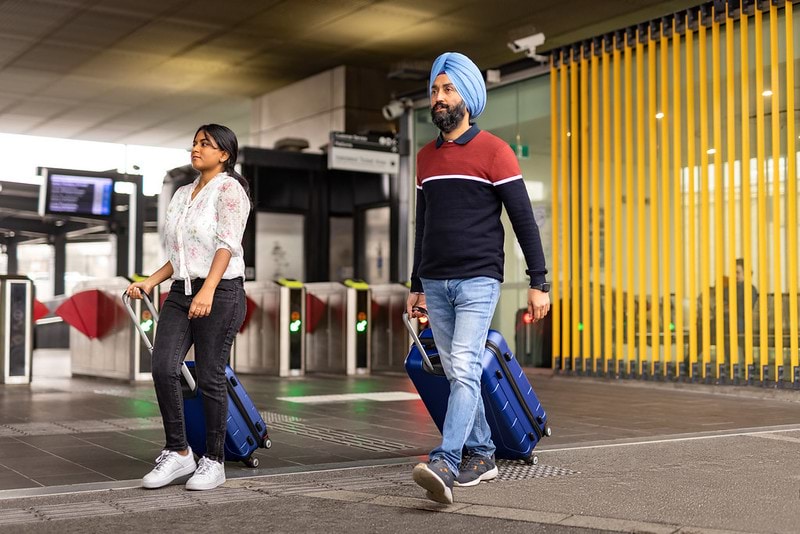
Implementation
The Strategic Framework will guide the development of DTP’s next Accessibility Action Plan, covering 2025 to 2029, and subsequent Action Plans. The upcoming Action Plan will include specific initiatives to improve accessibility across the transport and planning systems, aligning with the framework's vision and objectives. It will also track progress against the strategic directions and will be shaped by input from experts and people with disabilities.
Evaluation and reporting
The success of the Strategic Framework will be measured in the following four ways. Due to data constraints, initially these measures will apply only to public transport, with a view to expand to all forms of transport as information sources improve.
Governance
Governance
The Accessible Transport Advisory Committee will check progress in delivering the Strategic Framework. The Accessible Transport Advisory Committee, comprising representatives of the community with lived experience of disability, is appointed by the Minister for Public and Active Transport and provides independent reports and advice to all transport portfolio Ministers in relation to accessibility issues.
DTP has also engaged a Chief Accessibility Advocate reporting to the Secretary to provide independent advice on the performance of the Department about accessibility and to provide strong connections to people in the community with disability.
Major public transport operators have also established reference groups to advise them on accessibility. An overview of the Transport Accessibility Governance Arrangements can be seen below.
Ongoing evaluation and reporting on the Strategic Framework
Regular updates on the Strategic Framework will be included in DTP’s annual report of performance measures to track implementation and progress towards outcomes. These updates will show how the Strategic Framework is being implemented and how we are progressing towards our accessibility objectives and strategic directions. As shown in the diagram above, independent reviews of progress will be made by the Accessible Transport Advisory Committee.
Future updates of the Action Plan will then publicly report against steps taken in implementing the strategic directions and broader elements of Strategic Framework implementation when the Action Plan is refreshed.
